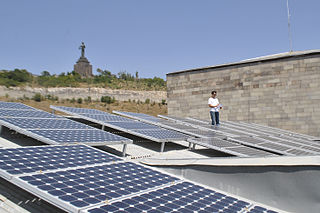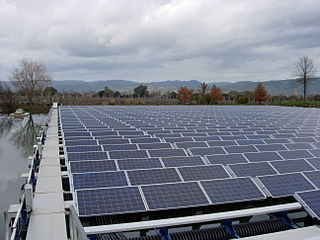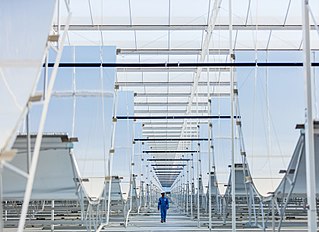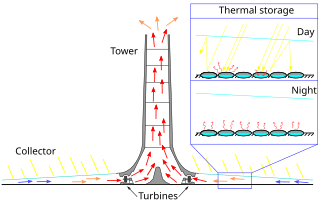 W
WSolar power is the conversion of renewable energy from sunlight into electricity, either directly using photovoltaics (PV), indirectly using concentrated solar power, or a combination. Concentrated solar power systems use lenses or mirrors and solar tracking systems to focus a large area of sunlight into a small beam. Photovoltaic cells convert light into an electric current using the photovoltaic effect.
 W
WSolar energy is widely available in Armenia due to its geographical position and is considered a developing industry.
 W
WThe following is a list of products powered by sunlight, either directly or through electricity generated by solar panels.Solar air conditioning Solar balloon Solar charger Solar backpack Solar cell phone charger Strawberry Tree Solar chimney Solar-powered waste compacting bin Solar cooker Solar dryer Solar-powered fan Solar furnace Solar inverter Solar keyboard Solar lamp Solar pond Solar road stud Solar street light Solar traffic light Solar Tuki Solar-powered flashlight Solar notebook Solar-powered calculator Solar-powered desalination unit Solar-powered pump Solar PV Junction box Solar-powered fountain Solar-powered radio Solar-powered refrigerator Solar-powered Stirling engine Solar-powered watch Solar-pumped laser Solar roadway Solar Spark Lighter Solar still Solar tree Solar vehicle Solar balloon Solar boat Tûranor PlanetSolar Solar bus Solar car Solar golf cart Solar panels on spacecraft Solar sail Solar thermal rocket.
 W
WAn absorption heat pump (AHP) is a heat pump driven by thermal energy such as combustion of natural gas, steam solar-heated water, air or geothermal-heated water differently from compression heat pumps that are driven by mechanical energy. AHPs are more complex and require larger units compared to compression heat pumps. In particular, the lower electricity demand of such heat pumps is related to the liquid pumping only. Their applications are restricted to those cases when electricity is extremely expensive or a large amount of unutilized heat at suitable temperatures is available and when the cooling or heating output has a greater value than heat input consumed. Absorption refrigerators also work on the same principle, but are not reversible and cannot serve as a heat source.
 W
WConcentrated solar power systems generate solar power by using mirrors or lenses to concentrate a large area of sunlight onto a receiver. Electricity is generated when the concentrated light is converted to heat, which drives a heat engine connected to an electrical power generator or powers a thermochemical reaction.
 W
WA concentrated solar still is a system that uses the same quantity of solar heat input as a simple solar still but can produce a volume of freshwater that is many times greater. While a simple solar still is a way of distilling water by using the heat of the sun to drive evaporation from a water source and ambient air to cool a condenser film, a concentrated solar still uses a concentrated solar thermal collector to concentrate solar heat and deliver it to a multi-effect evaporation process for distillation, thus increasing the natural rate of evaporation. The concentrated solar still is capable of large-scale water production in areas with plentiful solar energy.
 W
WA Dyson sphere is a hypothetical megastructure that completely encompasses a star and captures a large percentage of its power output. The concept is a thought experiment that attempts to explain how a spacefaring civilization would meet its energy requirements once those requirements exceed what can be generated from the home planet's resources alone. Because only a tiny fraction of a star's energy emissions reaches the surface of any orbiting planet, building structures encircling a star would enable a civilization to harvest far more energy.
 W
WFloating solar or floating photovoltaics (FPV), sometimes called floatovoltaics, is solar panels mounted on a structure that floats on a body of water, typically a reservoir or a lake.
 W
WThe Global Solar Atlas (GSA) is a free, online, map-based application that provides information on solar resource and photovoltaic power potential globally. It features the online interactive map tools, simplified photovoltaic (PV) power calculator, reporting tools and the extensive download section. It is intended to provide policy makers, academia, and renewable energy stakeholders to raise awareness in the solar energy domain, support the development of policies and plans, and for initial zoning and site identification purposes.
 W
WLuna Ring is a speculative engineering project which consists in a series of solar generators, disposed around the equator of the Moon, that could send the generated electric energy back to the Earth via microwaves from the near side of the Moon. The project was proposed by Japanese construction firm Shimizu Corporation, after the 2011 Tōhoku earthquake and tsunami destroyed the Fukushima Daiichi Nuclear Power Plant, creating public opposition against nuclear electric energy. Until then, Japan had relied heavily on nuclear power.
 W
WMiraah is a solar thermal energy plant that is under construction in Oman for the production of steam for solar thermal enhanced oil recovery. In July 2015, Petroleum Development Oman and GlassPoint Solar announced that they signed a $600 million agreement to build the 1 GWth solar field. The project will be one of the world's largest solar field measured by peak thermal capacity.
 W
WA perovskite is any material with a crystal structure similar to the mineral called perovskite, which consists of calcium titanium oxide (CaTiO3). The mineral was first discovered in the Ural mountains of Russia by Gustav Rose in 1839 and named after Russian mineralogist L. A. Perovski (1792–1856). The general chemical formula for perovskite compounds is ABX3, where 'A' and 'B' are two ions, often of very different sizes, and X is an ion (frequently oxide) that bonds to both ions. The 'A' atoms are generally larger than the 'B' atoms. The ideal cubic structure has the B cation in 6-fold coordination, surrounded by an octahedron of anions, and the A cation in 12-fold cuboctahedral coordination.
 W
WThe scaphe was a sundial said to have been invented by Aristarchus of Samos. There are no original works still in existence by Aristarchus, but the adjacent picture is an image of what it might have looked like; only his would have been made of stone. It consisted of a hemispherical bowl which had a vertical gnomon placed inside it, with the top of the gnomon level with the edge of the bowl. Twelve gradations inscribed perpendicular to the hemisphere indicated the hour of the day.
 W
WSmart modules are a type of solar panel that has a power optimizer embedded into the solar module at the time of manufacturing. Typically the power optimizer is embedded in the junction box of the solar module. Power optimizers attached to the frame of a solar module, or connected to the photovoltaic circuit through a connector, are not properly considered smart modules.
 W
WA solar combisystem provides both solar space heating and cooling as well as hot water from a common array of solar thermal collectors, usually backed up by an auxiliary non-solar heat source.
 W
WThe Solar Electric Light Fund (SELF) is a Washington, D.C. based nonprofit whose mission is to design and implement solar energy solutions to assist those living in energy poverty with their economic, educational, health care, and agricultural development. Since 1990, SELF has completed projects in more than 20 countries, using solar energy to power drip irrigation in Benin, health care in Haiti, telemedicine in the Amazon rainforest, online learning in South Africa, and microenterprise development in Nigeria.
 W
WThe Solar Electricity Handbook is a yearbook written by eco-technology author Michael Boxwell. It is a beginners technical manual for people looking to learn about solar energy and how to generate electricity from photovoltaic panels.
 W
WSpacecraft operating in the inner Solar System usually rely on the use of photovoltaic solar panels to derive electricity from sunlight. Outside the orbit of Jupiter, solar radiation is too weak to produce sufficient power within current solar technology and spacecraft mass limitations, so radioisotope thermoelectric generators (RTGs) are instead used as a power source.
 W
WSolar power forecasting is the process of gathering and analyzing data in order to predict solar power generation on various time horizons with the goal to mitigate the impact of solar intermittency. Solar power forecasts are used for efficient management of the electric grid and for power trading.
 W
WA solar power tower, also known as 'central tower' power plant or 'heliostat' power plant, is a type of solar furnace using a tower to receive focused sunlight. It uses an array of flat, movable mirrors to focus the sun's rays upon a collector tower. Concentrated solar thermal is seen as one viable solution for renewable, pollution-free energy.
 W
WSolar Ship Inc. is a company based out of Toronto, Ontario, Canada working to develop a hybrid aircraft to deliver critical cargo to cut-off places. The solarship gains lift from both buoyant gas and aerodynamics, and uses power from solar panels. The aircraft is a new concept of transport that does not rely on fossil fuels or ground infrastructure.
 W
WA solar still distills water with substances dissolved in it by using the heat of the Sun to evaporate water so that it may be cooled and collected, thereby purifying it. They are used in areas where drinking water is unavailable, so that clean water is obtained from dirty water or from plants by exposing them to sunlight.
 W
WThe solar updraft tower (SUT) is a design concept for a renewable-energy power plant for generating electricity from low temperature solar heat. Sunshine heats the air beneath a very wide greenhouse-like roofed collector structure surrounding the central base of a very tall chimney tower. The resulting convection causes a hot air updraft in the tower by the chimney effect. This airflow drives wind turbines, placed in the chimney updraft or around the chimney base, to produce electricity.
 W
WSpace-based solar power (SBSP) is the concept of collecting solar power in outer space and distributing it to Earth. Potential advantages of collecting solar energy in space include a higher collection rate and a longer collection period due to the lack of a diffusing atmosphere, and the possibility of placing a solar collector in an orbiting location where there is no night. A considerable fraction of incoming solar energy (55–60%) is lost on its way through the Earth's atmosphere by the effects of reflection and absorption. Space-based solar power systems convert sunlight to microwaves outside the atmosphere, avoiding these losses and the downtime due to the Earth's rotation, but at great cost due to the expense of launching material into orbit. SBSP is considered a form of sustainable or green energy, renewable energy, and is occasionally considered among climate engineering proposals. It is attractive to those seeking large-scale solutions to anthropogenic climate change or fossil fuel depletion.